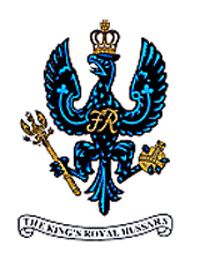Active 2 December 1992- Founded 1992 | Type Line Cavalry Role Armoured regiment | |
 | ||
Similar Queen's Royal Hussars, Royal Hussars, Queen's Own Hussars, Queen's Royal Lancers, Queen's Royal Irish Hussars | ||
King s royal hussars quick march
The King's Royal Hussars (KRH) is a cavalry regiment of the British Army. It is part of the Royal Armoured Corps. The regiment was formed in 1992 and is based at Tidworth. It serves as the armoured regiment of the 12th Armoured Infantry Brigade. Under Army 2020 Refine, it will exchange its Challenger 2 tanks for Ajax vehicles.
Contents
- King s royal hussars quick march
- King s royal hussars
- History
- Organisation
- Crimson trousers
- Brown beret
- The Gurkha link
- The Emperor
- Museum
- Alliances
- Affiliated Yeomanry
- Notable officers
- References
King s royal hussars
History
The regiment was formed on 4 December 1992 by the amalgamation of two other regiments:
The regiment was based at York Barracks in Münster at the time of amalgamation from where it deployed units to Northern Ireland on Operation Banner in June 1994 and to Bosnia and Herzegovina in January 1996: it spent its time as part of 2nd Canadian Multi National Brigade and was awarded the Canadian Forces' Unit Commendation - the first time that this had been awarded to a foreign unit.
The regiment deployed units to Bosnia and Herzegovina again in June 1997 and to both Bosnia and Herzegovina and Kosovo in autumn 1999. The regiment returned to Aliwal Barracks at Tidworth Camp in March 2000 from where it deployed units to Northern Ireland in October 2002; it also deployed units to Iraq on Operation Telic 1 in June 2003, Operation Telic 6 in May 2005 and Operation Telic 10 in June 2007. The regiment also deployed on Operation Herrick 7 in September 2007 and Operation Herrick 16 in April 2012.
Organisation
The regiment currently serves in the armoured role, equipped with Challenger 2 tanks, and is based in Tidworth, Wiltshire. It is planned to continue this role and retain its base under the Army 2020 reforms. The regiment is organised into a total of five squadrons, each of which perpetuates the title of one of its antecedent regiments:
C Squadron traditionally is the senior squadron of the King's Royal Hussars in perpetuation of the honour accorded to C Squadron the 11th Hussars in Egypt.
Crimson trousers
The regiment wears crimson trousers when in ceremonial, No. 1 or No, 2 dress, and (for officers and NCOs) mess dress. They may also appear in shirt sleeve order as worn by officers, including those on secondment to the regiment from other units. This distinctive feature, which is unique in the British Army, derives from the honour accorded to the 11th Hussars by Prince Albert, the future consort of Queen Victoria. The regiment, then based at Canterbury, formed the escort for the Prince from his arrival at Dover en route to his wedding in London. The Prince was so impressed with the bearing and turnout of the troops that he ordered that they should henceforth wear his livery as a mark of distinction.
Brown beret
The regiment wears a unique brown beret. This practice began when the 11th Hussars were mechanized in 1928. It was found that the traditional forage cap with a peak was inconvenient when peering through an armoured sight, so it was decided to adopt a beret. It is believed that the brown colour was selected by the then quartermaster's wife as a practical choice for working with dirty, oily vehicles, rather than nice, clean horses. The beret was originally worn without a cap badge but with a broad crimson band. On almagamation with the 10th Hussars PWO (the senior regiment of the two) who had a Red Patch behind their cap badge, it was agreed in discussions between representatives of both regiments (10th & 11th) to retain the patch but the colour was changed to Crimson to represent the Crimson band. Since 2003 the Royal Wessex Yeomanry has also worn the brown beret.
The Gurkha link
The regiment wear the crossed kukri of the Gurkhas as an arm badge. This relates back to 1945 when C Squadron, 14th/20th King's Hussars assaulted the town of Medicina in Italy alongside the 2nd Battalion, 6th Gurkha Rifles, inflicting heavy losses on the German defenders despite being outnumbered. In commemoration of this action the 14th/20th King's Hussars adopted the crossed kukri badge, a tradition maintained by the regiment.
The Emperor
During the Battle of Vitoria in June 1813 the 14th Light Dragoons captured from a French baggage train a silver chamber pot belonging to King Joseph Bonaparte which had been gifted from his brother Emperor Napoleon. The regiment gained the regimental nickname of "The Emperor's Chambermaids" and retained the chamber pot as a loving cup known as The Emperor. The King's Royal Hussars, as the successor to the 14th Light Dragoons, still retain The Emperor and it is used in by its officers on mess nights to drink from.
Museum
"HorsePower: The Museum of the King's Royal Hussars" is the regiment's museum, which is part of Winchester's Military Museums in Winchester, Hampshire.
